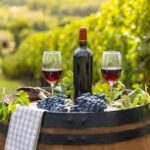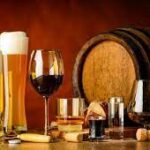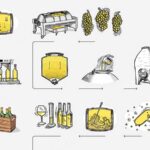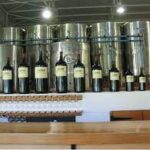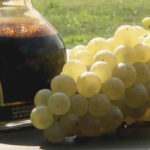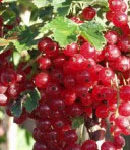Korygowanie wina „na sucho”.
Przez korygowanie wina należy rozumieć dodawanie do niego cukru, a przy pewnych gatunkach owoców także kwasu, lub też przy owocach o dużej kwasowości obniżanie jej. Korygowanie wina, przy produkcji na dużą skalę, jest ściśle określone przez prawo, ale my, sporządzając wino tylko na własny użytek, nie musimy się tak bardzo przejmować przepisami. Pomijając wina i soki naturalne, które produkowane są w dobrych latach bez żadnych dodatków i zabiegów (w każdym razie dotyczy to winogron i jabłek), istnieje pewien rodzaj podstawowego przepisu na sporządzanie win, na podstawie którego określa się ich jakość.
Zwykłe wino owocowe do picia, zwane moszczem winnym, ma co najmniej 40° Ochslego. Sok z naszego przykładu rachunkowego można zatem według tego kryterium zakwalifikować jako nadający się do użytku. W stosunku do tego rodzaju wina nie stawia się żadnych wymagań, poza jednym, powinno się je szybko wypić. Utrzymuje się ono najwyżej do następnej wiosny.
Z własnego doświadczenia wiem, że nie powinno się nastawiać wina z owoców ziarnkowych poniżej 60° Ochslego. W roku 1982 jabłka dały na przykład 62° w skali Ochslego.
Takie wino uchodzi jeszcze za całkiem lekkie i jest to najniższa wartość, którą musi się charakteryzować napój, jeśli ma przetrwać następne lato. Oczywiście nie jest to warunek konieczny; wino własnej roboty służy przede wszystkim do picia, a nie do tego, aby zaopatrzyć piwnicę w szlachetne i rzadkie rodzaje. Nawet przy największym wysiłku nasz produkt nie będzie do nich należał.
Inaczej rzecz się ma natomiast ze skorygowanymi winami, na które sok został wzbogacony dodatkiem cukru zgodnie z ustawą winiarską. Według przepisu podstawowego wina stołowe średnio lekkie zawierają maksymalnie 80° w skali Ochslego, a wina deserowe najwyżej 120-130°.
Sok zawierający 45° Ochslego wymaga więc dodatku cukru, aby mogło z niego powstać dobre wino stołowe o zawartości alkoholu 10,6% (80° Ochslego = 10,6% alkoholu). Aby wartość płynu podnieść o 1° w skali Ochslego, trzeba go wzbogacić dodatkiem 2,6 g cukru na litr. Aby więc osiągnąć pożądaną wartość 80° Ochslego trzeba dodać (80 – 45) = 35° Ochslego: 35 x 2,6 = 91 g/l. Na balon o pojemności 50 litrów byłoby to 4,55 kg.
Przeprowadzając obliczenia, można skorygować każdy sok owocowy, przeznaczony zarówno na wino stołowe, jak i deserowe.
Ale należy tu mieć jeszcze jedno na uwadze. W zwykłych winach stołowych o wartości do ok. 90° Ochslego cały cukier (w zależności od rasy drożdży i ich siły fermentacji) przerabiany jest na alkohol (+ dwutlenek węgla), a więc po zakończeniu fermentacji są one całkowicie przefermentowane, wytrawne.
Przy wyższym ciężarze moszczu w winach deserowych pozostaje nie przefermentowana reszta cukru, której drożdże nie są w stanie przerobić. Podczas pomiaru gotowego wina deserowego wskazania cukromierza będą się wahały pomiędzy 10° a 20° Ochslego. Więcej na ten temat przy opisie przeprowadzania fermentacji. Dokładniejsze dane, dotyczące sporządzania win stołowych i deserowych, znajdują się w części zawierającej przepisy. Ostrożne wzbogacanie moszczów charakteryzujących się niskimi wartościami w skali Ochslego przeprowadza się głównie przy winach stołowych, czyli w sokach z owoców ziarnkowych i z winogron, podczas gdy soki z owoców jagodowych powinno się przerabiać na wina deserowe. Wytrawne wina stołowe z tych ostatnich owoców mają zbyt ostry smak.
Do korygowania wina „na sucho” bierze się suchy cukier kryształ (nie cukier gronowy!) i rozpuszcza się go w ogrzanym moszczu. Dopiero wtedy, kiedy na dnie miski nie widać już kryształków cukru, roztwór można wymieszać z resztą soku.
Sok z owoców ziarnkowych powinien mieć ciężar rzędu co najmniej 55-60° Ochslego, aby mogło z niego powstać lekkie, młode wino. Szlachetniejsze wino stołowe (odpowiadające winom wyborowym) powinno być nastawione na 80° Ochslego, przy czym mam tutaj na myśli nie tylko wino z jabłek lub gruszek, lecz również wino z białych winogron. Czerwone wino z winogron może wykazywać 90° Ochslego. Wszystkie te wina przefermentowują do końca, są wytrawne. Wina deserowe nastawia się na 100-120, a nawet 130° Ochslego. Tego rodzaju wina zawierają w większej lub mniejszej ilości nie przerobiony cukier, słodycz resztkową. Aby gęstość soku owocowego zwiększyć o 1° Ochslego, trzeba liczyć 2,6 g cukru na litr.
